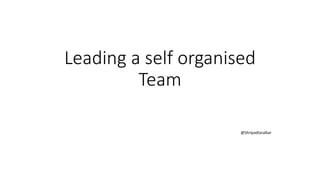
Leading a self organised team
- 1. Leading a self organised Team @Shripadtaralkar
- 2. What is a self-organising team? Self organising does not mean • The team gets to decide what goal they pursue • Even necessarily who is on the team “Self-organization is about the team determining how they will respond to their environment (and management can influence that environment).
- 3. CAS “Complex adaptive systems are a 'complex macroscopic collection' of relatively 'similar and partially connected micro-structures' – formed in order to adapt to the changing environment, and increase its survivability as a macro- structure.”
- 4. Example: CAS • Ant colony or bee hive • Flock of geese heading south • A family preparing, eating, and cleaning up after a meal • Us right now • A crowd queued up to get into a concert or sporting event • Cars on a highway • A software team
- 5. “Self-organisation does not mean letting people do whatever they want to do.” “It means that management commits to guiding the evolution of behaviors that emerge from the interaction of independent agents instead of specifying in advance what effective behavior is.” —Philip Anderson, The Biology of Business
- 7. To be sure, control is still exercised; but, it is subtle and much of it is indirect. —Peter DeGrace & Leslie Stahl Wicked Problems, Righteous Solutions
- 8. How Effective are They? As one of the principles behind the Agile Manifesto states, “The best architectures, requirements, and designs emerge from self-organizing teams.” Better, faster communication More trust between client & product team Less conflict Increased motivation Informed decision-making
- 9. Shape the Path • Self-organization is not something that happens one time • A team is never done doing it • The team continually re-organizes in a sense and-respond manner to its environment • As you see the team self-organize you can influence, but not control or direct, its path • We can view this as the evolution of a team
- 10. levers of influence 1. Selecting the external environment 2. Defining performance 3. Managing meaning 4. Choosing people & Reconfiguring the network 5. Energizing the system - Philip Anderson, “Seven Levers for Guiding the Evolving Enterprise.”
- 11. How do you do this? Environment • Enlarge or shrink teams • Enlarge or shrink the responsibility boundary of teams • Change team membership • Create new teams or groups
- 12. How do you do this? Nurture Diversity • Don’t require consensus • Creativity comes from tension • Quiet disagreement is not as good as fierce debate that leads to behavior change • Ask hard questions • Then expect teams to find solutions
- 13. How do you do this? Enforce Collaboration • Encourage communication between teams and groups • Who isn’t talking who should? • Add or remove people from exchanges • Change reporting relationships • Relocate people • Compliance with external groups • Encourage learning
- 14. What are the challenges of not doing it ? Traditional top down management Needs frequent attention in terms of direction Can be Very Demanding on the Users Time Costs can Increase Harder for new Starters to Integrate in the Team
- 15. Questions ?
Editor's Notes
- It’s a response to a Problem thrown at the team! All of us determine what's that challenge is going to be..
- Although project teams are largely on their own, they are not uncontrolled. Management establishes enough checkpoints to prevent instability, ambiguity, and tension from turning into chaos. At the same time, management avoids the kind of rigid control that impairs creativity and spontaneity. —Takeuchi & Nonaka “The New New Product Development Game”
- Simple rules or incentives are used to guide or direct behavior “Drive this direction and on this side of the highway.” For bioteams, these are provided by nature “Produce honey” For our teams, Rules and incentives can be added by managers or leaders…or in some cases by team members
- the key is the balance of, “an appropriate level of direction coupled with suitable delegation and trust.”
- From my own experience, self-managed teams make better decisions for the product and, therefore, for the business. For example, a Leadership Team can be brought together by anybody in the company to deal with almost any type of issue. The results have been very positive
- What business are we in? (OK, maybe you can’t influence this one, but someone can The company’s approach to innovation Fast follower or innovator? Are mistakes OK? When? Types of projects worked on and the rate at which they are introduced to the organization The principle of selection tells us that the traits that help us survive will be the ones retained Managers and leaders send messages about which traits should survive Leaders can push messages into the system e.g., putting the team in touch with customers Or keep messages out Meaning often comes from the stories, myths and rituals that are repeated “We will become profitable this quarter.” Clearly, who is on the team influences how they self-organize Adjust Some people are like “glue” and pull a team together and keep it there 4 Team Size Location Background Experience Decision-making style Gender Motivation Skepticism Communication paths (formal and informal) can be more important than the individuals You can introduce or remove flows To other teams, experts in the organization, customers Make sure the group has a “clear, elevating goal”† or an “igniting purpose”‡ Project chartering: Vision box, press release, magazine review, elevator statement Opportunity To learn, a bigger role, to go onto even better projects, and so on Information Customer visits, training, conferences, brown-bags
- Low confidence on problem solving for the business TAT Testers Required all the Time at the End
